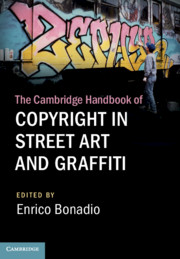Book contents
- The Cambridge Handbook of Copyright in Street Art and Graffiti
- The Cambridge Handbook of Copyright in Street Art and Graffiti
- Copyright page
- Contents
- Figures
- Contributors
- Foreword
- Foreword
- Introduction
- Part I Creativity in the Street Between Misappropriation and Destruction
- Part II National Legal Analyses
- Section A Americas
- Section B Europe
- 10 Street Art, Graffiti and Copyright: A UK Perspective
- 11 Graffiti, Street Art and Copyright in France
- 12 Street Art, Graffiti and Copyright: A German Perspective
- 13 Copyright in Street Art and Graffiti: An Italian Perspective
- 14 Copyright in Street Art and Graffiti in the Netherlands
- 15 Copyright Protection of Street Art and Graffiti in Greece: Intellectual Property and Personal Property in Conflict?
- Section C Africa, Asia, and Australasia
- Epilogue
13 - Copyright in Street Art and Graffiti: An Italian Perspective
from Section B - Europe
Published online by Cambridge University Press: 14 November 2019
- The Cambridge Handbook of Copyright in Street Art and Graffiti
- The Cambridge Handbook of Copyright in Street Art and Graffiti
- Copyright page
- Contents
- Figures
- Contributors
- Foreword
- Foreword
- Introduction
- Part I Creativity in the Street Between Misappropriation and Destruction
- Part II National Legal Analyses
- Section A Americas
- Section B Europe
- 10 Street Art, Graffiti and Copyright: A UK Perspective
- 11 Graffiti, Street Art and Copyright in France
- 12 Street Art, Graffiti and Copyright: A German Perspective
- 13 Copyright in Street Art and Graffiti: An Italian Perspective
- 14 Copyright in Street Art and Graffiti in the Netherlands
- 15 Copyright Protection of Street Art and Graffiti in Greece: Intellectual Property and Personal Property in Conflict?
- Section C Africa, Asia, and Australasia
- Epilogue
Summary
Art and drawings on walls have existed for long time in Italy. It is an anthropological phenomenon whose millennial existence is confirmed by the rock paintings in the Camonica Valley in North Italy as well as the engravings on the Colosseum in Rome and on the walls of Pompeii.
The first Italian publications documenting art in the street are the works “Graffiti a New York” published in 1978 by Andrea Nelli, a university dissertation offering a clear and detailed analysis of the thriving New York writing culture of that era; and ‘Arte di Frontiera’ by art critic and researcher Francesca Alinovi, published in 1982 in the Flash Art magazine, and documenting the kids with spraycans from the poverty-stricken neighbourhoods of the city, about their impudence, their energy, and the way a new lettering-based art was created and developing fast. In 1984, the (then) Gallery of Modern Art in Bologna completes the innovative research by Alinovi (who in the meantime had been killed in a mysterious murder case) and organises ‘New York Graffiti’, one of the first European exhibitions entirely dedicated to graffiti artists like Futura 2000, Lady Pink, Daze and Toxic.
Keywords
- Type
- Chapter
- Information
- The Cambridge Handbook of Copyright in Street Art and Graffiti , pp. 207 - 223Publisher: Cambridge University PressPrint publication year: 2019

